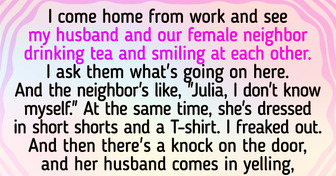I Refuse to Babysit My 3 Stepchildren for Free

Approximately 10,000 years ago, people in Mesopotamia started taming animals for food, dairy, and skins. The skins of the domesticated animals were utilized for creating garments, storage containers, and tents. Goats were likely the initial species to be domesticated, and sheep followed shortly after. As a result, the same animals started to look different, and it’s only natural that many people would have trouble telling the difference between wild and domesticated species.
A Missouri farmer recently captured a mysterious and unusual-looking cat that had been spotted on his property for months. It was identified as an African serval by the Turpentine Creek Wildlife Refuge, and it likely escaped from a captive situation and was left to fend for itself. However, the rescuers believe that its survival would not have lasted much longer, as it was not adapted to the cold winter climate of the Midwest.
According to the refuge, the serval weighs 29 pounds, making it roughly three times heavier than the average domestic cat. It is estimated to be around five years old, which is roughly one-fourth of its typical lifespan.
It’s widely believed among researchers that the gray wolf is the progenitor of the domesticated dog. The time frame of this transformation is believed to have taken place anywhere from 32,000 to 14,000 years ago. However, there’s a minority of scientists who argue that dogs may have descended from an extinct wild ancestor, potentially similar to modern-day pariah dogs or dingoes. Regardless of its origins, the dog remains the first animal to have ever been domesticated by humans.
Centuries of affection toward dogs has led to the creation of over 400 breeds of domestic dogs. Studies on the origin of dogs and their special bond with humans are still ongoing.
Humans selectively bred the bezoar, also known as the wild goat, as the second species of wild animal. At first glance, these agile, wiry ungulates may not seem like ideal candidates for domestication, but their capacity to convert scarce plants into valuable resources such as hides, meat, and milk made the effort worthwhile for settlers in the Fertile Crescent. The breeding of these animals began as early as 11,000 years ago and resulted in generations of solitary goat herders.
The domestic goat now boasts over 200 distinct breeds. Ranging from tiny miniatures kept as household pets, to cashmere goats with soft coats used for textiles, to large animals weighing close to 300 pounds.
Around 10,000 years ago, several subspecies of this wild sheep (mouflon) were brought down from the mountains. Their offspring eventually became the ancestors of early Ugg boots and shearling jackets. It wasn’t until several thousand years later that wool-producing varieties emerged. Early on, they were killed for their hides and meat instead of being bred for wool production.
The domestic sheep encompasses over 200 breeds, from breeds that produce excessive amounts of wool and require regular shearing to avoid overheating, to tropical varieties with smooth coats similar to goats. Despite the sheep’s reputation for being docile and easily managed, some breeds have displayed remarkable levels of intelligence, including the ability to recognize their own names.
Approximately 9,000 years ago, someone daringly captured a group of wild boars, likely in present-day Turkey. Chinese and European wild boars were probably domesticated independently. Regardless of their origins, their descendants were relegated to living off of human waste. In ancient towns, pigs were commonly seen roaming the streets, eating garbage, and providing a readily available source of meat.
The once-fierce wild boar has been domesticated into about 70 breeds of domestic pig, ranging from pink pigs to large, hairy breeds adapted to specific environments. Despite being widely discredited, pigs are highly intelligent animals. Recent medical advancements suggest that they may even be used to grow new hearts for transplantation.
The ancestry of cattle can be traced back to the extinct aurochs. Similar to several other species, cattle were most likely domesticated on multiple occasions. The first instance of domestication took place about 10,500 years ago in Iran. The zebu is believed to have originated from the Indian subspecies of the aurochs, approximately 6000 years later.
African cattle have evolved from the earlier line and were later interbred with the indicus type, known for its distinctive hump, which provides better adaptation to warm climates. There are over 800 recognized breeds of cattle, although only a small portion of these are acknowledged by breed organizations. The world cattle population is estimated at 1.5 billion.
Earlier beliefs held that goldfish were descendants of the Crucian carp, but recent studies have revealed that they either come from the closely related Prussian carp or are a result of hybridization. Unlike their domesticated counterparts, wild goldfish possess a muted color palette of metallic greens instead of vibrant oranges and whites. The selective breeding of mutant forms of goldfish began in China about 2000 years ago. During the Tang Dynasty, goldfish ponds became a popular landscaping feature in China.
Despite the unfortunate tradition of handing out goldfish as carnival prizes, leading to the death of many of these pets, goldfish are also a popular food source for captive carnivorous fish. If properly cared for, goldfish can live for over a decade, yet many still succumb to premature deaths.
Approximately 6,000 years ago, wild horse were domesticated in the regions now known as Kazakhstan. During its early domestication, the horse was utilized for transportation and was also a source of food. The present-day horse has evolved greatly, and its wild ancestor is now extinct.
Today’s horse boasts more than 200 recognized breeds and hundreds of additional local breeds not recognized by breeding organizations. In 2013, there was a controversy when a European food processing company mislabeled horse meat as beef, which led to several recalls of products containing the meat.











